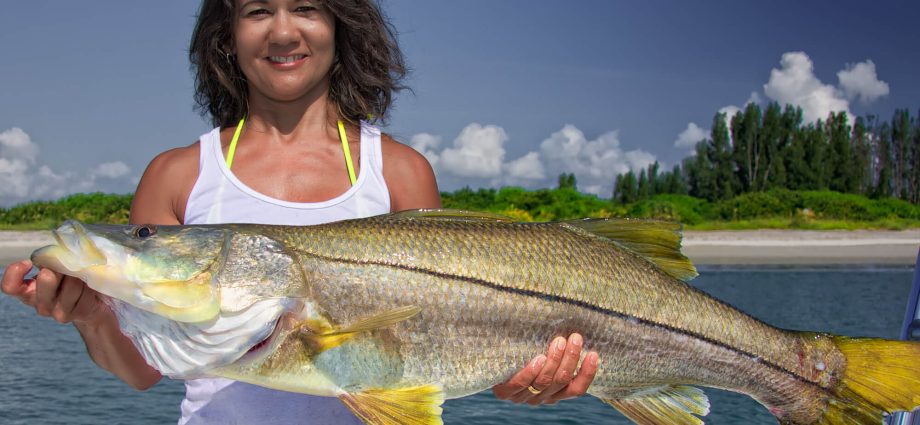Contents
Useful information about snook fishing
Marine fish, outwardly similar to freshwater pike perch, but not related species. This is a fairly large genus of marine fish, numbering about 12 subspecies, but differing slightly from each other. Anglers, as a rule, do not separate these fish among themselves and all are called snook or robalo. Robal species are divided into three groups: American robal, African-Asian latex, Asian ambassis. Actually, American robalo snooks are divided into Pacific and Atlantic. There are three popular types: comb, black and thick robalo. The long-spined robalo is considered the smallest species, its weight reaches 1 kg and its length is 30 cm. In all species, the main features are similar: the head is large, strongly flattened, the lower jaw protrudes forward, and there are a large number of sharp teeth in the mouth. On a light body, a dark lateral line is strongly visible. All snooks have two dorsal fins that touch each other. Robalos are large, aggressive predators. Weight can reach more than 20 kg and length more than 1m. The usual size of trophies reaches a length of about 70 cm. A feature of the behavior of snooks is that they actively feed in the coastal zone and are excellently caught when fishing from the shore with amateur gear. The fish is quite widespread, it is a commercial species; in addition to sea water, it lives in brackish waters of estuaries and lower reaches of rivers. Snooki are susceptible to water temperature when below 280C can go to more comfortable places. Due to the voracity of this fish, you can quickly adapt to the habits and successfully fish on your own.
Fishing methods
Robalo is an active, demersal predator that takes both moving and stationary natural baits. This is also related to fishing methods. To the list of traditional amateur gear for catching fish in fishing tours (fly fishing, spinning), float and bottom fishing rods are added. Because snook prefers to hunt in the coastal zone, mangroves and the estuary zone, it is much easier for fishermen who are used to fishing in small bodies of water to adapt to fishing for it than for other fish in the vast tropical seas. Like most coastal marine predators, snooks are especially active during high tide periods and also at night.
Catching fish on a spinning rod
When choosing tackle for fishing on a classic spinning rod for fishing on a robalo, it is advisable to proceed from the principle: “trophy size – lure size.” An important point is that snooks are caught from the shore, walking along sandy beaches. Various vessels are more convenient for spinning fishing, but even here there may be limitations associated with fishing conditions. Snooks stay in the lower layers of the water, but they are also caught on poppers. The most interesting is fishing for classic baits: spinners, wobblers and more. Reels should be with a good supply of fishing line or cord. In addition to a trouble-free braking system, the coil must be protected from salt water. In many types of sea fishing equipment, very fast wiring is required, which means a high gear ratio of the winding mechanism. According to the principle of operation, the coils can be both multiplier and inertial-free. Accordingly, the rods are selected depending on the reel system. When fishing with spinning marine fish, fishing technique is very important.
Fly fishing
Snuka is actively fished for sea fly fishing. In most cases, before the trip, it is worth clarifying the size of possible trophies. As a rule, one-handed fly fishing tackle of class 9-10 can be considered “universal”. Rather large baits are used, so it is possible to use cords a class higher, corresponding to one-handed marine rods. Volumetric reels must correspond to the class of the rod, with the expectation that at least 200 m of strong backing must be placed on the spool. Do not forget that the gear will be exposed to salt water. This requirement applies especially to coils and cords. When choosing a coil, you should pay special attention to the design of the brake system. The friction clutch must be not only as reliable as possible, but also protected from salt water ingress into the mechanism. Fly fishing for saltwater fish, and snook in particular, requires a certain amount of lure handling technique. Especially at the initial stage, it is worth taking the advice of experienced guides. Fishing is very emotional when catching snooks on a popper.
Baits
For fishing with spinning gear, various baits are used, wobblers and their modifications are considered the most popular. Including various surface models. The same applies to fly fishing lures. For fishing, a large number of different volumetric imitations of fish and crustaceans are used. Very often the most effective are superficial in the style of “popper”. Snook fishing is often offered using the simplest rigs baited with natural baits: small fish, fish fillets, mollusk meat or crustaceans, sea worms.
Places of fishing and habitat
Snooki (American robalos) are common off the coast of Central America on both the west and east coasts. Subspecies occupy different ranges, but intersect with each other. The crested robalo lives off the coast, in the basins of both the Pacific and Atlantic oceans. They prefer to stick to sandy beaches, as well as brackish lagoons and estuaries. In addition to America, fish of the genus robalo are distributed from the African coast to the Pacific Islands.
Spawning
It spawns in summer near estuaries and in brackish waters. During the spawning period, it forms large aggregations.










